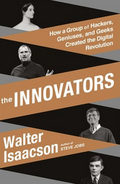 The history of computing has me firmly in its grip and so after having read “Fire in the Valley” I continued with “The Innovators”. While the latest edition of the previous book mainly focused on what was going on in Silicon Valley in the 1970s to the 1990s, “The Innovators” expands the story back to Charles Babbage and Ada Lovelace in the 1850’s and ends in the 21st century with the creation and evolution of Google.
The history of computing has me firmly in its grip and so after having read “Fire in the Valley” I continued with “The Innovators”. While the latest edition of the previous book mainly focused on what was going on in Silicon Valley in the 1970s to the 1990s, “The Innovators” expands the story back to Charles Babbage and Ada Lovelace in the 1850’s and ends in the 21st century with the creation and evolution of Google.
“The Innovators” is of course much briefer about what happened in Silicon Valley in the 1970s to 1990’s than the previous book I read. Instead it tells the stories of many other people, how they built on work of their predecessors and how their success was usually due to working in a team rather than doing something on their own all the way as it is often portrayed elsewhere. Also, it doesn’t focus on developments in only a single location it mentions how Konrad Zuse came up with his electromechanical computer in Germany in the 1940’s, Alan Turing in Great Britain, the computers that were built in Britain after the war, how the ENIAC in Philadelphia came to be, the women behind programming ENICAC like Grace Hopper and Jean Jennings, the story of John von Neumann, the Atanasov-Berry computer, how the transistor was invented, again by a team, at Bell labs, etc., etc., etc.
Beginning in the 1960’s the book then continues the the story with the move from transistors to integrated circuits and how Silicon Valley mushroomed from Shockley Semiconductors to Fairchild to Intel and, what I found to be one of the many interesting new insights I gained, that Intel was founded not as a processor company but to produce memory chips as that was seen as the major application of integrated circuits once it was understood of how to cram more than just a few transistors on a die. The microprocessor on a chip only came later and was not envisioned as a product when Intel was created.
I could go on and on about the book but to make it short, I very much enjoyed reading it as it doesn’t only convey facts but also tells the stories of the people and gives a sense of who these people were, how they were growing up and what drove them to do what they did.